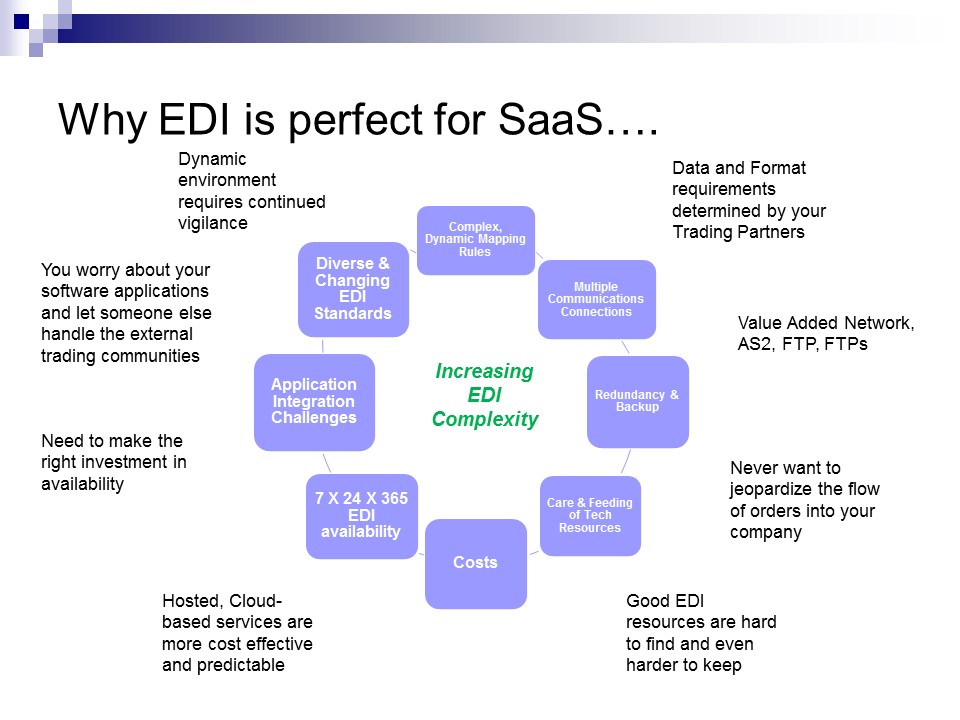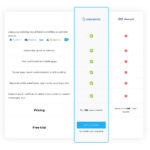Are you tired of the complexities and limitations of traditional Electronic Data Interchange (EDI) systems? It’s time to explore the world of EDI alternatives. These alternatives offer innovative solutions that can streamline your business operations and improve efficiency. Say goodbye to the days of manual data entry and hello to a more flexible and accessible way of exchanging electronic documents.
EDI alternatives have come a long way in transforming the way businesses exchange information. With the rise of cloud technology, businesses now have the option to leverage web-based EDI platforms that eliminate the need for expensive on-premises hardware and software. This not only reduces costs but also provides scalability and flexibility for businesses of all sizes. In fact, according to a recent survey, 63% of businesses reported cost savings after implementing an EDI alternative, while 85% experienced increased efficiency in their supply chain processes. It’s clear that embracing EDI alternatives can have a significant impact on your business operations.
Looking for alternatives to traditional EDI systems? Consider adopting more flexible and cost-effective solutions, such as API integration or cloud-based platforms. These options offer streamlined data exchange, real-time visibility, and seamless collaboration. With API integration, you can directly connect with partners and automate transactions, while cloud-based platforms provide scalability and accessibility. Embrace the future of data exchange with these innovative EDI alternatives.

Exploring Alternatives to EDI
In today’s fast-paced digital landscape, businesses are constantly looking for efficient ways to exchange data and streamline their operations. Electronic Data Interchange (EDI) has long been the standard for transmitting business documents between trading partners. However, with advancements in technology, there are now several alternatives to EDI that offer more flexibility, affordability, and ease of use. In this article, we will explore some of the popular EDI alternatives that businesses can consider.
Here are some viable alternatives to EDI:
1. API Integration
API integration allows businesses to connect their systems directly to the systems of their partners or service providers. This enables real-time data exchange and seamless communication between different applications. Instead of manually processing and sending documents, API integration automates the process, reducing errors and improving efficiency.
API integration offers several advantages over traditional EDI, including:
- Real-time data exchange
- Easy scalability
- Flexible customization
- Lower implementation and maintenance costs
With API integration, businesses can integrate their systems with partners using predefined APIs or build custom APIs for seamless data exchange. This alternative is particularly beneficial for businesses that require real-time updates and need to rapidly respond to changing market conditions.
2. Web Portals
Web portals provide a user-friendly interface for trading partners to exchange documents and collaborate on business transactions. Instead of relying on complex EDI software, businesses can access the portal through a web browser, making it easy to onboard new partners and simplify the document exchange process.
Some key benefits of using web portals as an EDI alternative include:
- Accessibility from anywhere with an internet connection
- Simple and intuitive user interface
- Reduced training and onboarding time
- Lower infrastructure and maintenance costs
Web portals are especially useful for small and medium-sized businesses that do not have the resources to invest in EDI infrastructure. With web portals, partners can easily upload and download documents, track shipment status, and communicate with each other, all within a centralized platform.
3. Managed File Transfer
Managed File Transfer (MFT) solutions provide a secure and reliable way to exchange files between systems, partners, and customers. MFT solutions offer enhanced security features like encryption, authentication, and audit trails, ensuring the protection and integrity of data throughout the file transfer process.
Here are some advantages of using MFT as an alternative to EDI:
- Secure file transfer with advanced encryption
- Automation of file transfer processes
- Centralized control and monitoring
- Compliance with data protection regulations
MFT solutions can handle a variety of file formats and integrate with existing systems, allowing businesses to seamlessly exchange files with their partners and customers without the complexity of traditional EDI. This alternative is particularly suitable for industries where data security and privacy are critical, such as healthcare and finance.
4. XML/JSON Messaging
XML and JSON are popular data exchange formats used for structured data communication over the internet. Instead of using the fixed format of EDI, XML and JSON provide a more flexible and human-readable way to represent data. XML/JSON messaging allows businesses to exchange data in a format that is easily understood by both humans and machines.
Benefits of using XML/JSON messaging include:
- Flexibility to represent complex data structures
- Easy integration with existing systems
- Compatibility with web services and APIs
- Efficient and lightweight data transmission
XML/JSON messaging is widely used in modern web development and can be seamlessly integrated with various systems and technologies. This alternative is particularly suitable for businesses that leverage web services and APIs for data exchange.
Comparing EDI Alternatives
To compare the different EDI alternatives, let’s take a look at their key features and considerations:
| Alternative | Key Features | Considerations |
| API Integration | – Real-time data exchange – Easy scalability – Flexible customization |
– Requires technical expertise – Upfront development costs |
| Web Portals | – Accessibility from anywhere – Simple user interface – Reduced onboarding time |
– Limited real-time capabilities – Manual document processing |
| Managed File Transfer | – Secure file transfer – Automation of processes – Compliance with regulations |
– Separate system for data mapping – Additional set-up and maintenance |
| XML/JSON Messaging | – Flexibility of data representation – Easy integration with systems – Lightweight data transmission |
– Requires data transformation – Lack of standardization |
It’s important for businesses to evaluate their specific requirements and choose the EDI alternative that best aligns with their needs and goals.
Conclusion
As technology continues to evolve, businesses have a wide range of alternatives to traditional EDI. API integration, web portals, managed file transfer, and XML/JSON messaging offer flexible and cost-effective options for data exchange. By carefully assessing their requirements, businesses can choose the alternative that best serves their needs and enables seamless collaboration with their trading partners.
Key Takeaways: EDI Alternatives
1. API Integration can be an alternative to EDI for exchanging data between systems.
2. Cloud-based solutions offer flexibility and scalability as a substitute for traditional EDI.
3. Managed File Transfer (MFT) allows secure transmission of data without the need for EDI.
4. Web-based portals provide a user-friendly interface for data exchange without EDI.
5. Electronic Data Interchange (EDI) alternatives can help businesses streamline their data exchange processes.
Frequently Asked Questions
Here are some common questions and answers regarding EDI alternatives.
1. What are the alternatives to EDI?
There are several alternatives to traditional EDI, including:
One alternative is API integrations, which allow for real-time data exchange and seamless communication between systems. API integrations provide more flexibility and agility compared to EDI.
Another alternative is web-based portals, where trading partners can exchange data and documents through a secure online platform. This eliminates the need for EDI software and infrastructure investment.
2. What are the advantages of API integrations as an EDI alternative?
API integrations offer several advantages as an EDI alternative:
Firstly, API integrations enable real-time data exchange, allowing for faster and more accurate information sharing between systems. This leads to improved efficiency and decision-making.
Additionally, API integrations provide greater flexibility and scalability. They are easier to implement and maintain compared to traditional EDI systems, making them more suitable for businesses of all sizes.
3. How do web-based portals compare to EDI?
Web-based portals offer several advantages over traditional EDI systems:
Firstly, web-based portals are accessible through a web browser, eliminating the need for specialized EDI software. This makes it easier for trading partners to collaborate and exchange data.
Web-based portals also provide a user-friendly interface, allowing for easy navigation and document management. They offer a more intuitive and modern approach to data exchange compared to EDI.
4. Can API integrations and web-based portals work together?
Absolutely! API integrations and web-based portals can work together to create a comprehensive and efficient data exchange system.
API integrations can be used to connect systems and facilitate real-time data exchange, while web-based portals can provide a user-friendly interface for trading partners to access and manage their data.
5. Are there any risks or challenges associated with EDI alternatives?
While there are many advantages to using EDI alternatives, there are also some risks and challenges to consider:
One challenge is the need for secure data transmission. It is important to ensure that appropriate security measures are in place to protect sensitive information when using API integrations or web-based portals.
Another challenge is the potential for compatibility issues between different systems. It is important to carefully evaluate and test the compatibility of the chosen alternative with existing systems to avoid any data integration problems.

In summary, when considering alternatives to electronic data interchange (EDI), it is important to explore more modern and efficient options. These alternatives can include cloud-based platforms, application programming interfaces (APIs), and electronic document exchange (EDE) systems. These solutions offer increased flexibility, scalability, and cost-effectiveness for businesses of all sizes.
By adopting these alternatives, businesses can streamline their data exchange processes, improve communication with trading partners, and enhance overall productivity. It is crucial for organizations to stay abreast of technological advancements and leverage these alternatives to stay competitive in today’s digital landscape.








